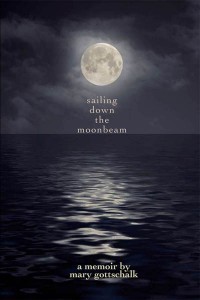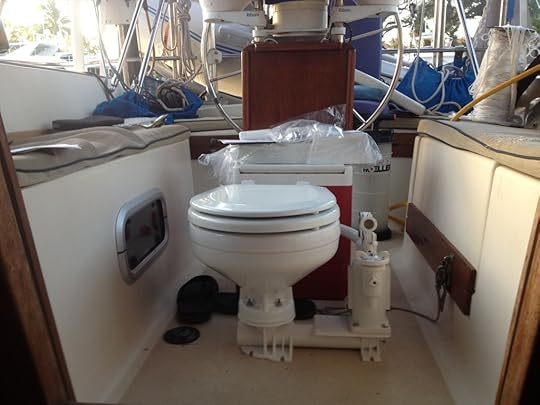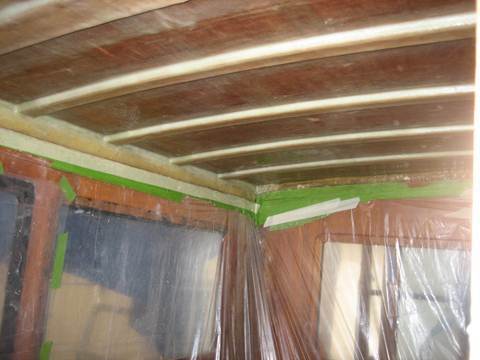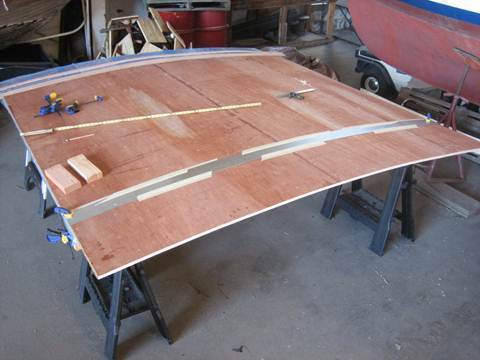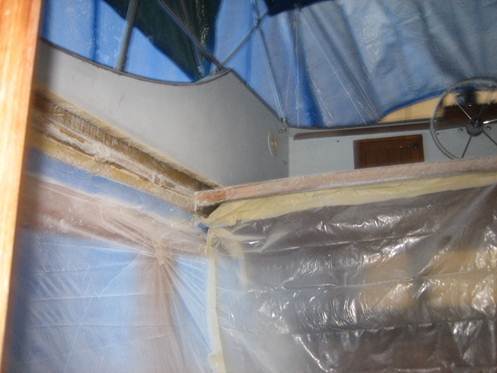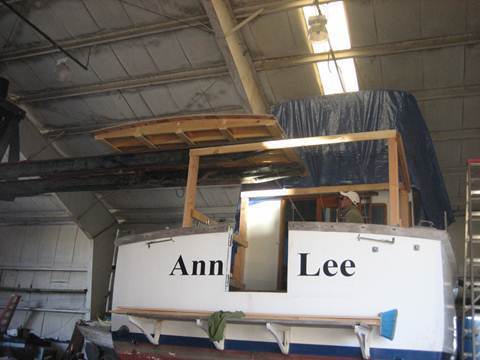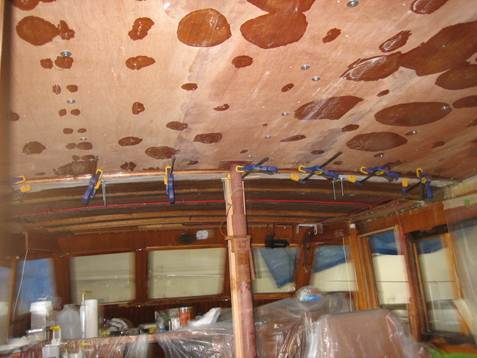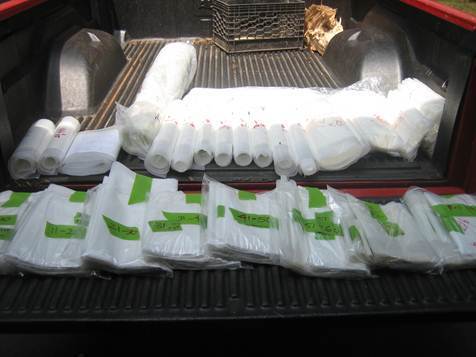Mike Jastrzebski's Blog, page 57
August 23, 2012
Christine welcomes guest Mary Gottschalk
One of the best things about our Write on the Water blog is the way it has drawn so many people who also love both writing and boating. Today, it is my great pleasure to welcome Mary Gottschalk who has written a lovely memoir about her sailing life on the boat pictured above. But I really should let her tell you the tale about how these two passions led her to find a greater wisdom about life. Enjoy! CK
Mindfulness
by Mary Gottschalk
I love the idea of a blog called Write on the Water, of finding a way to merge the best of both the sailing and the writing worlds. Sadly, I don’t seem to be able to do them both at the same time.
It has been nearly three decades since I last lived on a sailboat, but much of what inspires my writing comes from what I learned over many years on the water. I’ve always seen sailing as a world in which the road to your destination is not well marked, the route you take depends on the weather, and sometimes you end up in a place very different from where you thought you were heading when you set out.
In other words, sailing is a metaphor for life.
That metaphor took on much richer meaning when my husband and I abandoned successful careers at age 40 for a five-year circumnavigation of the globe. In fact, we only made it halfway (New York to New Zealand), but it was nearly ten years before I returned home. Having “dropped off” off the professional track at an age where the path to success begins to narrow, I returned to a career that was much more satisfying than I ever could have imagined if I’d remained in New York instead of going sailing.
So, herewith, three perspectives on sailing as a metaphor for life.
Learning to Live Small
When Tom and I decided to go sailing in September of 1985, we had to put our life into storage. The pearls Tom gave me on my 37th birthday. The wine cellar he began collecting while in college. Crystal wine glasses. Oriental rugs. Everything.
For months, I worried about the warehouse burning down. Insurance might replace our “things” but not their emotional content. Thus, it came as a surprise, six or seven months into our voyage, when I realized what a relief it was not to be worrying about breaking a crystal goblet or spilling red wine on my carpets or having my jewelry stolen.
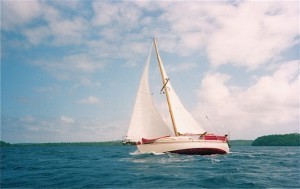 And with less to worry about, I had more energy to observe the texture of daily life. The web of multi-colored highlights spreading across the water as the sun rose in the morning. The dolphins playing in the bow wake. The curving path of a snail crossing the sand.
And with less to worry about, I had more energy to observe the texture of daily life. The web of multi-colored highlights spreading across the water as the sun rose in the morning. The dolphins playing in the bow wake. The curving path of a snail crossing the sand.
Before long, I began to hope the warehouse would burn down.
It didn’t and in due course I got all my “stuff” back. But by the time I got it back, the memories had faded with age (theirs and mine). Although I’ve given away or sold much of it, what little I’ve kept often feels burdensome. Every time someone spills wine on the carpet or breaks a glass, I regret once again that the warehouse did not burn down.
Learning to be Mindful
Tom and I didn’t have to wait long for our sailing plans to go awry. Two weeks out of New York, as we headed down the Intracoastal Waterway, we ran smack into Hurricane Gloria. We tucked into a hurricane hole, but our anchor broke lose as the eye of the storm passed over us and we were blown into a stand of cypress trees. When the storm ended, our hull was encased in five feet of mud and our propeller shaft was bent. After being hauled out, we limped to the tiny town of Belhaven, NC for repairs.
One evening during our stay, we sat swapping sea stories with Alan, the Harbormaster. As we described our itinerary—the countries we planned to visit and how long we planned to stay—Alan shifted visibly in his seat.
When he could contain himself no longer, he shook his head. “You two are doing it all wrong. If you plan everything in advance, you’re missing the whole point of your journey. The best experiences are almost always the ones you didn’t plan for.”
At first, we were offended. We’d labored so hard to make sure we could get to all the places we wanted to see in the five years we’d set aside for the trip. But, here we were, two weeks out and already a week behind schedule. In a face-off between our itinerary and the elements, Mother Nature would win every time.
In retrospect, Alan’s advice wasn’t really about our itinerary. It was about living life in real-time. Buddhists call it mindfulness, the art of living in the moment. Alan’s message was that if you walk into any situation expecting it to be a certain way, the odds of being disappointed are very real. But if you have no expectations, you have unlimited opportunities for discovery and adventure.
Belhaven was definitely not one of our destinations. But it was a place we needed to go … not just to repair our propeller but more importantly, to repair our mindset.
Learning to Love Living Out of Control
Every sailor knows that the basic elements of the boating life— the wind, the weather and the current—are out of your control. But Tom and I were experienced sailors and it never really occurred to me that I could die at sea.
That is, until one sunny day 18 months into our voyage, in the middle of the Pacific Ocean, miles from the shipping lanes. That day, a group of experienced yachting friends failed to check in on the scheduled ham net. We laughed, at first, about too much partying the night before or a dead battery due to engine trouble. But when the yacht did not re-appear after several days, I could not avoid the possibility that something catastrophic had happened on a beautiful day in the middle of nowhere. And that the probability of being rescued was close to zero.
If it could happen to them, of course, it could happen to us. For the first time in my sailing career, I understood, in the pit of my stomach, that my life could end at any moment, without warning.
I fought panic for nearly a week, berating myself for giving up a comfortable life in New York City for an existence that was so fragile.
And then one gorgeous night with the full moon marking out our southwesterly course on the sea’s surface, it dawned on me that my comfortable life in New York had been an illusion. I’d been so busy trying to control the small details of daily living—racing to get onto the subway before the door closed … getting to the movie early enough to get good seats … planning a cruising itinerary with arrival and departure dates five years out—that I’d never stopped to think about all the big things that could snuff my life out in an instant.
A brick falling off the façade of a building on Madison Avenue as I walked by. A drunk in the wrong lane of the Saw Mill River Parkway. A fire in my high-rise apartment building. A stroke.
But even worse, all that busy-ness had been in service of yet another illusion. I had no more control over the subway door than I had over the drunk on the highway. I had no more control over whether a guest broke a wine glass than I had over the arrival of a hurricane.
As I watched the moonbeam dancing on the water ahead of our bow, I realized how much time and energy I had wasted trying to manage things, big and little, that were ultimately uncontrollable. The cruising life had already taught me to be content with the uncontrollable nature of wind and weather. Now, it was teaching me to be content with uncontrollable nature of life itself. It was teaching me to love living out of control.
 Mary Gottschalk is retired and living in Iowa, much too far from the world of serious sailing. In 2008, she published Sailing Down the Moonbeam, a memoir about her journey from New York to New Zealand. She is currently working on a novel she expects to publish in early 2013. She also works as a freelance writer and speaker. www.sailingdownthemoonbeam.com
Mary Gottschalk is retired and living in Iowa, much too far from the world of serious sailing. In 2008, she published Sailing Down the Moonbeam, a memoir about her journey from New York to New Zealand. She is currently working on a novel she expects to publish in early 2013. She also works as a freelance writer and speaker. www.sailingdownthemoonbeam.com
Share on Facebook
What Would Hemingway Do? (WWHD?)
C.E. Grundler
Working alone in a shed at the far corner of a boatyard provides me plenty of time to think, and curling up in the forward cabin with my laptop, well beyond any internet signals, leaves me hours of distraction-free time to write. But it doesn’t sell books. These days, I’m told, if you want to sell books, social networking is the way to go. And while I spend my days working on the boat, in every sense of the word, my fellow authors are actively working online, posting to Facebook, Tweeting, and commenting, as well as utilizing numerous other social network platforms I’ve yet to explore.
True, I’ve blogged for years, though originally my blog wasn’t even a blog, but simply a web page documenting a previous boat restoration. When I began, it gave me a way to easily share pictures and stories with a small circle of friends. The content has since branched into other areas and attracted more readers, and I’ve linked it (sort of — there’s still some kinks) to Facebook, yet blogging remains my main, albeit sporadic, online presence. But these days, new platforms are emerging at an accelerating rate, and I realize as an author, it would serve me well to learn and use these latest ways of reaching out to a wider audience.
Instead, I continue to split my time between my family, an old boat, and writing. And the other day, while I yet again cut my way through yards of fiberglass, I found myself wondering: is this what I should be doing if I ever hope to achieve greatness. Okay. Just kidding. I’ll settle for reasonable mid-list-ish-ness. But seriously, if some of the ‘great’ authors of days gone by were alive today, how would they spend their time? Would they be out, living life and writing about it, or would they be hunkered down in the glow of their computer monitors, chained to their WiFi signals like dogs by an invisible fence as they delved into the many layers of social media and networked with their fellow authors and readers?
Would John Steinbeck be sharing on Tumblr?
Would Mark Twain ask readers to ‘like’ him on Facebook?
Would Edgar Allen Poe attend Thrillerfest?
Would Emily Dickinson post her Pintrests?
Would Jane Austen frequent Reddit?
Would Jules Verne be updating his Author Page?
Would Agatha Christie be Linkedin?
Would Ernest Hemingway Tweet?
I know this social networking thing works, and I’ve seen how the authors most adept at it have a distinct advantage when it comes to reaching and connecting with readers. Don’t construe that I’m knocking social networking – if anything, I wish it came more naturally to me. I’m simply wondering how authors of the past, the ones who rose to iconic status, would deal with social networking. If they ignored it, would they still have risen to the heights that they did? And if they embraced it, would they still have had time to write on a level that made them the authors we know today?
And on that note, I’m posting this and unplugging my computer. I have much work to do.
Share on Facebook
August 19, 2012
Walkin’ down C dock
By Mike Jastrzebski
We’ve been here at Harbortown Marina for about six weeks now, and I must admit I’m enjoying our new home. We spent six years in Ft. Lauderdale and I never did feel at home. I don’t have that problem here. The other boaters have gone out of their way to make us feel at home.
Rough Draft’s slip on C dock
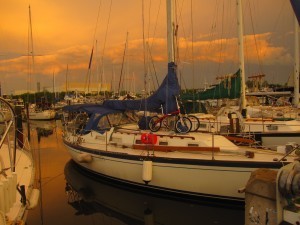
There are about thirty liveaboard boats in the Marina, but things don’t really get hopping until the weekend when the part-timers show up. The weekend boaters are a mix of power boaters and sail boaters, and they have one thing in common with the liveaboards, they love the water and they love their boats.
Since the dock is long, and we’re near the end, we have to pass the gauntlet of boaters when we go to the head, the car, or the pool. It’s a rare weekend day that we aren’t offered a drink or a humorous comment as we make our way along the dock, and it’s easy to make friends. I could easily stay here for a long time.
The problem with marina life is that it’s a little like I imagine listening to a siren’s song. It’s seductive, calls to you, and when you get close, it grabs you and won’t let you go. It’s why so many people never leave the docks. It’s why I’m pushing hard to get the boat ready to leave, and it’s why we’ve set a tentative early November date for leaving. We were trapped in Fort Lauderdale for six years and I won’t let it happen again.
So if you find yourself stuck at the dock put in some earplugs to block out that seductive song, set a date, and go no matter what. You won’t regret it. I know we haven’t.
August 16, 2012
On getting a head … or it’s about time
by Christine Kling
Okay, so I quit my job and moved onto my boat to write. Right? What a glorious lifestyle and a dream come true. Without the day job to eat up all my daylight hours, I should be getting so much more writing done all while sipping piña coladas on the fantail in the late afternoon sun.
But here’s the thing I didn’t fully realize when I started down this path a little over a year ago. Becoming a self-published author who is trying to support herself through her writing has made me into an entrepreneur who is running a significant small business out of her home. Quit my job? Ha! I just found myself another one. Blogging, tweeting, Facebooking and posting on email lists and forums is as confusing and exhausting as managing promotions and placing advertising. Formatting books, printing out manuscripts, deciphering contracts for foreign rights and working with editors on both self-published and traditionally published works eats up all those daylight hours I used to spend grading student papers. Notice I haven’t even mentioned writing new books yet. And because I am working from home, it has become even more imperative that I do everything I can to try to get a head.
No, that’s not a typo. I mean a head. As in W.C., toilette, john, pissoir. You see, the old one’s crapped out, so to speak.
At present, I am living aboard my 33-foot sailboat in a city marina and this place does have nice shoreside facilities which I can and do walk to without too much inconvenience. However, the head compartment on my boat is still the place where I do things like brushing hair and teeth and storing my showering gear.
I’d been putting up with a leaky head and its accompanying malodorous condition while I was in the Bahamas where I lived with open hatches and steady trade winds to carry said odors away but since arriving back to Florida in July and August, I have found it necessary to close up the boat and rebreathe the air conditioned air. And since when I’m in the marina, the head itself doesn’t get much flushing, said river water leaking out of the head pump tends to take on a decidedly darkish hue.
I knew I had to do something when even the dog couldn’t take the smell.
So, last Sunday, I set about removing the old porcelain bus. Two days, one can of penetrating oil, and several bleeding knuckles later, I finally lined the main cabin with puppy pee-pee pads and hugged the odiferous, dripping beast to my chest while I made my dash for the cockpit. Stepping over the lifelines and leaping onto the dock went far better than the moment when I had to lift the thing over my head to pitch it into the dumpster – at that moment, the plumbing gushed a half gallon of trapped water down the front of my T-shirt, and the toilet seat flipped open, caught me in the face, and gave me a fat lip. Thank God I’m a fiction writer because when people asked me why I was in the marina ladies room for the next hour washing my mouth out with soap, I wasn’t about to fess up to the origin of my injury.
Then began the task of trying to follow the plot of the plumbing. The previous owner of this boat was obviously a seat-of-the-pantser, not an outliner. I’ve calculated that there are roughly 25 feet of sanitation hose in this boat, broken down into six different sections that lead in and out of a holding tank, through a macerator, both forward and aft and to two separate thru-hull fittings. Frankly, if the Coast Guard would allow it, I’d love to dump a few of these sub-plots, but I don’t think I can get away with it.
Thanks to regular doses of vinegar and the fact that I use head pumping (minimum 15 pumps per flush) as part of my daily aerobic routine, the hose is not as bad as I expected. I might not have to replace all of it.
So, for days whilst I’ve attempted to edit this mess into something coherent, the new throne has sat in my cockpit, the shower grate below has been covered with tools, the salon is decorated with all the contents of the head lockers, and I’ve been trying to figure out how to replace the inevitable broken bolts on the base where I will attach my new head.
And this is why it’s about time. It’s about time lost doing boat work, and it’s about time to get back to my writing business (which in spite of the hours at the computer is something I dearly love) and stop spending so much time trying to get a head.
Fair winds!
Christine
Share on Facebook
It’s all in the little things…
C.E. Grundler
Yet again, one of John Urban’s posts got me to thinking, and led to what I’m going to talk about today. He was absolutely right, there are many pitfalls when it comes to kids and boating, and it’s a delicate line between establishing a life-long love of the water and all that floats, or winding up with offspring that avoid anything boat-related like the plague.
Myself, I don’t know if I even stood a chance. I was aboard boats from my earliest days – my parents claim ‘boat’ was among my first words, and it’s likely it will be among my last as well. Maybe that’s the key – getting kids out on the water before they’re too young to know any better. I preferred a rolling deck to a grassy backyard. To me, a cramped, tiny cabin was a cozy refuge. One of my favorite places to sleep was directly over the engine hatch in the salon, warmed and lulled to sleep by the steady rumble of twin diesels below me. And the engine room itself was a place of wonders. I was fascinated by the workings of those GMC 453s, and as the smallest crew member, often found myself sent down between them and instructed through various tasks. And that was a big factor as well. I felt I was an integral part of the boat’s upkeep and operations. I had responsibilities and I took pride in them, and eventually was presented with my own little ship (sailing dinghy) to command.
My daughter, unfortunately, doesn’t share my passion. Truth be told, she has mixed feelings when it comes to boats, and this circles back to John Urban’s DON’T list. When my daughter was younger, my husband tried to instill in her a love of the boating he’d grown up with. That boating involved a 14’ aluminum johnboat that would be loaded on the car’s roof before dawn, along with an extensive list of fishing gear. We’d haul up to a lake, launch and load the boat, (a process that usually involved a number of those expletives) then sit there in the silence of a chilly dawn, watching the sun rise and fishing. The boat was tippy, sucked the warmth from your body, and amplified any shuffling from a restless child to a volume my husband proclaimed would scare away every fish for 100 miles. And one big thing John missed on his list was *DON’T* keep small children captive aboard an open boat with no head – while a thermos of tea will fend off the cold, at least temporarily, eventually it leads to repeated calls for shore leave. As the children in question grow older, they’ll ultimately have something — anything — to do other than go fishing.
As my daughter was coming up on her teens I got my catboat. My husband, a non-sailor if ever there was one, had little interest in the boat. My daughter, however, often came aboard. She could care less for actually sailing, but was helpful, agreeable crew and enjoyed simply being out on the water. I’d be at the tiller and she’d lounge in the cockpit, basking in the summer sun, or curl up in the cabin, nestled on some pillows and reading or napping. We’d anchor and swim, or explore a beach. We followed no set schedule and we kept the boat well-provisioned with our favorite foods. The little stove could heat some soup or a pot of tea… and when mother nature called, there was a port-a-potti and privacy. We had a lot of great days aboard that boat, and even the worst ones left us with memories we still laugh about.
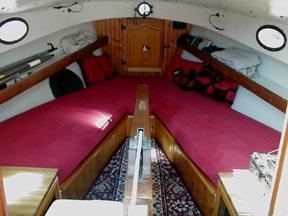
A few simple comforts go a long way.
I think the bottom line is that you can’t expect, simply because you enjoy something, your children will grow to feel the same. But I do believe if you focus on making their experiences, whatever they may be, as positive, happy and comfortable as possible, they’ll come away with good memories of those days.
Share on Facebook
August 14, 2012
Kids & Boating, Failure & Success
Some of life’s greatest rewards come from the joy of passing-down knowledge honed through generations of experience. Examples of this are evident along the waterfront where young kids take up sailing with their parents. In the process, they learn valuable lessons of ecology, self-reliance, and teamwork. At least that’s what I am told. I say this because I largely failed on this front.
Why have I fallen short? Like many questions in life, I suspect the answers are right in front of me if I choose to look. But let’s not get too introspective. This is, after all, just an escapist boating blog for dreamers who want to quit their jobs and sail away to islands of bliss.
We can, though, learn from other’s mistakes. With this in mind, let me offer readers a short-cut to better boating outcomes with kids.
Simply put, the keys to better boating are found in creating pleasant, safe, rewarding experiences.
What? Too much apple pie without much specificity?
Okay. If you really want to get your kids into boating, it’s more about avoiding the “don’ts.” Here’s a list of 10 points of wisdom:
1) Don’t pick a windless day with rolling seas for your kid’s maiden voyage;
2) Likewise, avoid cumulus-filled force-five days that require safety harnesses for those initial sails;
3) Remember to explain that “watch for the boom” isn’t a warning of an imminent explosion;
4) Avoid stepping on your daughter’s stuffed animal when you go forward to free a line;
5) Stay current on your towing insurance and keep your radio batteries charged;
6) Give the kids meaningful roles and turns at the helm, preferably before they’re about to toss their cookies;
7) Despite their status as the lightest crew members, avoid the temptation of sending the kids up the mast in the bosun’s chair;
8) Consider that young crew members may misinterpret your outbursts of four-letter expletives as signs of anxiousness;
9) Reassess the need to dock after three failed approaches, especially so if the above mentioned four-letter expletives come into play; and
10) Despite all of the the above, the most important don’t is: don’t rush things. Kids are resilient and they need to take things at their own speed and in their own time. Just ask Laura & Reid after they had a recent turn at the helm of the 12-meter American Eagle during a very special birthday celebration for their lovely mother, Sally.

Share on Facebook
August 13, 2012
Learning to write
I’m 100+ pages into my next Mick Murphy Key West Mystery and, because I’m writing it darker and differently than the other book in the series, it has been a lot of fun having past incidents threaten to change characters’ character.
I’ll be at a signing this Saturday, at Fast Buck Freddie’s Pop-Up Writers event on Duval and Fleming streets, in Key West, 6 – 8 pm, so if you’re on island for any reason, stop in and say hi. The event includes other Key West writers and the once popular store is being used as a Pop-Up art gallery, so there’s a lot to see besides writers.
Often, at signings or casual meetings with fans, writers are asked a few stock questions. How do you come up with ideas? When did you decided to be a writer? (By the way, btw for you tablet freaks, writing chooses you, you don’t choose writing). How did you learn to write? So, speaking for one, we have come up with stock answers.
Since I’m writing a sequel, I’d like to dwell on the last questions. How did I learn to write? It’s a many-sided question. I know there are great writers out there that went to Harvard and other colleges and learned to write there. Then there is a dwindling of old school writers that learned to write by being journalists, think Ernest Hemingway.
I had my feet in both ponds and I’ve often said I learned more from seasoned journalists while an office boy (not PC, but that’s what I was back then) at the Boston Record-American/Sunday Advertiser. Warren Walworth and the Gilhooley brothers taught me more about putting sentences together that would keep a reader reading than any college class ever came close to.
I should point out that I’m not talking about journalism today. Sadly, what existed in the ‘50s & ‘60s has all but died and it was the greatest school available to a kid who flunked high school English but loved books and writing.
So, you could say, my learning to write began back at the old newspaper with guys who drank too much, smoked too much and loved their work too much.
When I left Boston, I still loved to read. Reading is the best school for writers, since journalism is dying. What got me to thinking about this has a lot to do with what I’m writing now, tentatively titled “Key West Latitude.” My critique group of writers doesn’t like it, but it’s a working title and I can worry about a new title when the book is finished.
When I’m writing, or well into a book, I like to read other writers that I respect for their story-telling habits. I’ll read Robert Crais, Tom Corcoran, Don Bruns, James Hall, Bob Morris, Dennis Lehane or James Lee Burke. Well, as luck would have it, Burke has a new book out, “Creole Belle.” I began it and read it carefully, enjoying his prose and dialogue, as well as his plot.
Of course, I read many other writers but don’t waste my times on writers I don’t enjoy and there are a few of them out there too. I write mysteries, as we all know, so I read in the mystery-thriller genre. I read for enjoyment but also to learn and I learn a lot from Burke and the others. I learn what works and sometimes what doesn’t work. You read Burke’s Dave Robicheaux series and even if you’re stuck in a Montana snowstorm, you find yourself swatting at imaginary mosquitoes attacking your neck! He’s that good.
How do these writers do what impresses me? That’s what I try to figure out while wondering if whatever that is will work in my writing. Sometimes yes and sometimes no. But reading has taught me to try various things that impressed me.
Crais turning his Elvis Cole books into Joe Pike books gave me the idea of opening my book in progress from Norm’s voice. The book is darker and a sequel to “Stairway to the Bottom” and, if you’ve read it, the ending leaves Mick Murphy’s changed forever. I knew how I wanted to the new book to open but couldn’t see Murphy telling the story. Because I am a fan of Crais, I’ve read all his books and thought about changing POV. It took me a while to get it straight, believable, but once I did, I was off to the races.
If you want to write, you have to read and know why you like what it is you’re reading or what makes you dislike it. The good stuff you make work in your style, the bad stuff you remember not to use.
www.michaelhaskins.net
Share on Facebook
August 12, 2012
Cruising: It’s a full-time job
By Mike Jastrzebski
I’ve come to realize that living on a boat and cruising is a full time job. I’ve finally finished fixing all of the problems that popped up while we were in the Bahamas. Now, I’ve got to do the things I didn’t get done before the trip.
We plan to leave Cape Canaveral in November and work our way down to Miami before heading back to the Bahamas. From there where we go is anyone’s guess. That leaves me less than 3 months to prepare. I’ve been looking into ways to mount solar panels on the boat. Our bimini is not sturdy enough to handle a big panel so we’ve decided to add a good set of dinghy davits. We plan to mount a 250 watt panel on the davits, but standard davits aren’t tall enough to raise the panel high enough to avoid shading from the bimini. I’ve done my research and I think I’m going to have the davits made to order from Garhauer Marine Hardware. I’m going to call them this week and get a quote. If all works out I’ll blog about it and post some pictures.
I also bought a router from Al Francone over at WiFi Solutions for my Lynx antenna. It has worked perfectly, allowing me to connect to the marina wifi with my iPad and allowing Mary to connect with her netbook.
I’ve also decided that instead of mounting my radar dome on the mast, I’m going to put up a mast pole behind the cockpit, and this week I’m going to order a water bladder to increase our water capacity. We have a large storage area beneath the V-berth that I plan to use for the bladder. It will be a pain, and a bit time consuming, but we just don’t carry enough water for cruising.
On the writing front I’ve started outlining what will become my Abaco Wes Darling book. The working title is Stranded Naked Blues, but it may become Junkanoo Blues, or even Abaco Blues. The writing is moving slowly, but I hope to have the boat work done by mid-October and then I’ll turn most of my energy toward the book.
Next week maybe I’ll share my to-do list for the boat and let our readers weigh in on whether they think I can get everything done in 2 1/2 months.
Share on Facebook
August 9, 2012
Top ten things NOT to do when editing a manuscript
by Christine Kling
I read recently that the best way to get traffic to your blog is to be sure that you offer valuable information to your readers. In the light of that finding, I’m offering to you the wisdom I have acquired during the past week in the form of this list of the top ten things not to do when trying to edit a 530-page book on deadline.
10. Don’t decide to print out your entire manuscript on your boat with your portable printer that prints 5 ppm and has a 50 sheet feed. Five hours later you will remember, Kinko’s is your friend.
9. Don’t decide that this is a good time to give up caffeine. Wine is not the beverage of choice for these projects that require you to actually be awake.
8. Don’t allow yourself to obsess over one word out of 148,000. For example, in one scene set in 1942 on board a submarine, I have a character talk about washing the stink of the sub out of his clothes. My first editor told me to change the pronoun “he” to “they” because he was an officer and surely he wouldn’t wash his own clothes. Now my new editor says nobody on the sub would wash his clothes for him. So, I’ve been doing research and posting on forums asking if anyone knows if he would have hired someone or done it himself. Note to self: Move on.
7. Don’t make any major changes to the plot in chapter 3 that will have ramifications in chapters 17, 43, 66, 67 and 80. It will give you a killer migraine.
6. Don’t turn on the TV (yeah, Mike, it will render your brain useless).
5. Don’t tell yourself “This is going to be easy,” when you decide you must make your manuscript shorter –– especially when your editor keeps asking you to explain things. Granted, as an English major, math is NOT my strongest subject, but even I know that cutting 1,000 words here and then adding 1,200 words there does not add up to a shorter book.
4. Don’t decide that this is a great time to get a new computer and spend the first three days of your editing week moving files from one computer to another and deciding to completely reorganize your digital life. This comes under the heading of procrastination.
3. Don’t decide to take a break by doing a little dog training. You will only make yourself feel totally inept in two areas of your life.
2. Don’t then try to distract your new puppy with a Kong toy stuffed full of peanut butter. Remember, peanut butter contains sugar! Be prepared to have slimy toys dropped into your lap for the next four hours as what was once a cute little puppy turns into a Tasmanian Devil.
And finally, the last one that will make everything else I’ve written here make complete sense ––
1. Don’t let a blog deadline fall on the night before your manuscript deadline!
Fair winds!
Christine
Share on Facebook
Finished… sort of…
C.E. Grundler
It might not be pretty, but in some ways, it’s downright beautiful. In my eyes, it could just as well be the ceiling of the Sistine Chapel. And yet again, it’s another project that, once all is said and done, no one will ever see.
For those who haven’t been following my ongoing trails with the salon ceiling/bridge deck, I’ll recap what brought me to this point. My boat’s previous owner, I was told, was very fond of bright decks, and his preferred method for keeping them bright involved a belt sander. Years of this technique eventually took the teak decks down to the fasteners, at which time planks loosened, and he remedied that by adding larger (and longer) screws, ones that penetrated the fiberglass beneath the teak, and the structural core beneath that fiberglass. Water followed that route, and over years of freezing and thawing, delaminated a large section. Fortunately, that coring was solid teak lumber so there was no rot, but with fiberglass above and below, it remained water-saturated and would perpetually weep into the cabin in the few spots it found an exit.
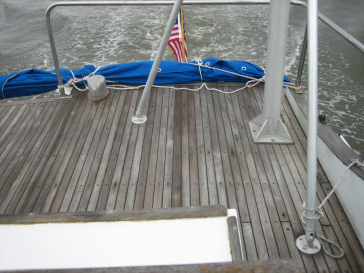
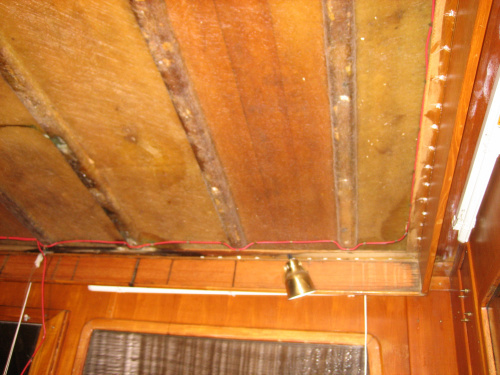
What this picture doesn’t show is just how delaminated this section is. At first, a few simpler methods were considered, yet due to the extent of the delamination, in the end it came down to removing the entire area of damage, rebuild a new core of marine-grade mahogany ply, laminated in layers to match the original camber, new ribs, and re-glass it in from above and below.
Step one. Remove old teak decking. Not pretty or easy.
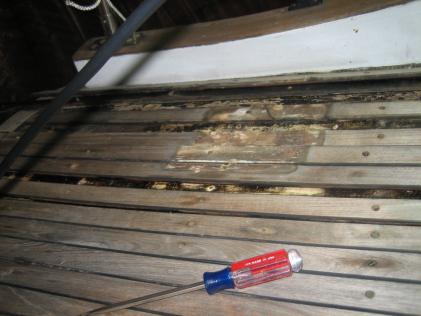
Step two. Determine that what lies beneath is beyond repair. Build a new core.
Cut massive hole in boat. (Stiff drinks afterward strongly recommended.)
I can assure you, cutting away large sections of your boat is the stuff of nightmares. Next, forklift replacement core, still on its frame, up to boat. The structure in the cockpit was built to hold it at the proper height so the laminate could be slid into place in the cabin.
New core, lagged into position. From below you can see where epoxy followed the screws used to ‘clamp’ the layers together as they were joined. The screws were removed and the holes filled with thickened epoxy. Lots of sanding ahead, to give those areas of epoxy sufficient tooth to hold the upcoming laminates.
Next, laminate in ribs and filet the edge, (guess I didn’t get any pictures) and then cut fiberglass. Lots of fiberglass. All bagged and numbered in order of layup, because the last thing you want to find yourself doing one epoxy is setting is look for that right piece.
Mix epoxy. Wet out surface. Wait for it to ‘kick’, lay up glass, repeat. Well over 100 pieces, once all was said and done. Once that first round of epoxy is applied, there’s no turning back, and setting resin waits for no one.
And there you have it. Remember, working with the right materials is vital. West Systems are a two-part epoxy, though I do believe a small portion of that third bottle pictured is critical when undertaking work of this sort.
What these photos can’t convey is the countless hours, which stretched into days, weeks, and months, that it took to complete each step. This entire undertaking could make a wonderful tutorial on why one should never wonder what lurks beyond the headliner unless they intend to forge ahead or do their best to ignore the effects of delamination. Neither is a pleasant option. And I do realize that while I’ve been toiling away, these problems and worse exist among the many boats that are happily being operated and enjoyed by their unknowing owners, which goes to show that ignorance truly is bliss. Non-itchy, non-sticky bliss. Unfortunately for me, I’ve always been of the mind that what you don’t know can hurt you. And no, this isn’t over yet. Next, the exterior will be laminated with a mix of mat and biaxial/mat fiberglass. Once all is finished, it should be stronger than the original layup, as well as completely sealed.
Share on Facebook


